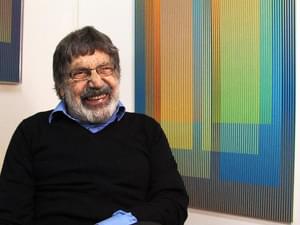Carlos Cruz-Diez
Carlos Cruz-Diez (b.1923) is a Venezuelan artist concerned with colour, light and the implication of movement in his work. He joined many artists from around the world in Paris in 1960, where members of various international movements of kinetic and light art had congregated and would form the beginnings of Op Art.
Influenced by Josef Albers, in 1959 Cruz-Diez began to consider progression, transformation and radiation of colour through constructed surfaces, and he abandoned paint as a medium. His work became divided into four sub-categories of self-defined op art: Physichromies, Chromointerferences, Chromosaturations, and Transchromies. His colour-based experiments are activated by variations of the observer’s position in relation to the work, the light directed at the work, and the relationship between the colours presented.
His work is highly respected internationally, and is represented the collections of the Museum of Modern Art (MoMA), New York; Tate Modern, London; Musée d’Art Moderne de la Ville de Paris; Centre Pompidou, París; Museum of Fine Arts, Houston; Wallraf-Richartz Museum, Cologne, and others.
Available works by Carlos Cruz-Diez
Available Artists
- Albers Anni
- Andre Carl
- Avery Milton
- Baldessari John
- Bell Larry
- Brice Lisa
- Crawford Brett
- Dadamaino
- Dávila Jose
- de Tollenaere Saskia
- Downing Thomas
- Dyson Julian
- Francis Sam
- Freud Lucian
- Gadsby Eric
- Gander Ryan
- Guston Philip
- Haring Keith
- Held Al
- Hockney David
- Hui Zhang
- Kapoor Anish
- Katz Alex
- Kelly Ellsworth
- Knifer Julije
- Kusama Yayoi
- Le Parc Julio
- Leciejewski Edgar
- Léger Fernand
- Levine Chris
- LeWitt Sol
- Lichtenstein Roy
- Maripol
- Martin Agnes
- Martin Jason
- Martin Kenneth
- Mavignier Almir da Silva
- Miller Harland
- Morellet François
- Motherwell Robert
- Nadelman Elie
- Nemours Aurélie
- O'Donoghue Hughie
- Pettibone Richard
- Picasso Pablo
- Prehistoric Objects
- Prince Richard
- Quinn Marc
- Riley Bridget
- Ruscha Ed
- Scott William
- Shrigley David
- Smith Anj
- Smith Richard
- Smith David
- Sonnier Keith
- Soto Jesús Rafael
- Soulages Pierre
- Taller Popular de Serigrafía
- The Connor Brothers
- Turk Gavin
- Vasarely Victor
- Warhol Andy
- Wesselmann Tom
- Wood Jonas
- Wool Christopher
